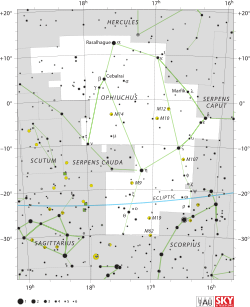Gamma Ophiuchi
Gamma Ophiuchi, Latinized from γ Ophiuchi, is a fourth-magnitude star in the constellation Ophiuchus. Based upon an annual parallax shift of 31.73 mas as seen from Earth, it is located 103 light years from the Sun. The system has an age of roughly 184 million years.[3] It is moving closer to the Sun with a radial velocity of −7.6 km/s.[5]
 | |
| Observation data Epoch J2000.0 Equinox J2000.0 | |
|---|---|
| Constellation | Ophiuchus |
| Right ascension | 17h 47m 53.55973s[1] |
| Declination | +02° 42′ 26.2000″[1] |
| Apparent magnitude (V) | +3.753[2] |
| Characteristics | |
| Spectral type | A0 V[3] or A1VnkA0mA0[4] |
| U−B color index | +0.040[2] |
| B−V color index | +0.033[2] |
| Astrometry | |
| Radial velocity (Rv) | −7.6±0.3[5] km/s |
| Proper motion (μ) | RA: −24.64[1] mas/yr Dec.: −74.42[1] mas/yr |
| Parallax (π) | 31.73 ± 0.21[1] mas |
| Distance | 102.8 ± 0.7 ly (31.5 ± 0.2 pc) |
| Absolute magnitude (MV) | +1.26[5] |
| Details | |
| Mass | 2.9[3] M☉ |
| Radius | 1.8[6] R☉ |
| Luminosity | 29[3] L☉ |
| Surface gravity (log g) | 4.03[4] cgs |
| Temperature | 9506[3] K |
| Rotational velocity (v sin i) | 220[7] km/s |
| Age | 184+93 −134[7] Myr |
| Other designations | |
| Database references | |
| SIMBAD | data |
It is known also as Muliphen,[8][10] although at least two more stars are known with this name: Gamma Canis Majoris (often spelled as Muliphein) and Gamma Centauri (often spelled as Muhlifain).[10]
This is an A-type main sequence star with a stellar classification of A0 V.[3] Gray et al. (2003) lists a classification of A1VnkA0mA0,[4] indicating it is of type A1 V with the calcium K-line and metallic lines of an A0 star. It has nearly three times the mass of the Sun and 1.8 times the Sun's radius.[6] The star shines with 29[3] times the luminosity of the Sun, which is being emitted from its outer atmosphere at an effective temperature of 9506 K.[3] It is radiating an excess emission of infrared, suggesting the presence of a circumstellar disk of dust at an orbital radius of 64 AU from the host star.[3]
References
- van Leeuwen, F. (2007). "Validation of the New Hipparcos Reduction". Astronomy and Astrophysics. 474 (2): 653–64. arXiv:0708.1752. Bibcode:2007A&A...474..653V. doi:10.1051/0004-6361:20078357.
- Cousins, A. W. J. (1984), "Standardisation of broad band photometry of equatorial standards", South Africa Astronomical Observatory Circular, 8: 59–67, Bibcode:1984SAAOC...8...59C.
- Wyatt, M. C.; et al. (July 2007), "Steady State Evolution of Debris Disks around A Stars", The Astrophysical Journal, 663 (1): 365–382, arXiv:astro-ph/0703608, Bibcode:2007ApJ...663..365W, doi:10.1086/518404
- Gray, R. O.; Corbally, C. J.; Garrison, R. F.; McFadden, M. T.; Bubar, E. J.; McGahee, C. E.; O'Donoghue, A. A.; Knox, E. R. (2006). "Contributions to the Nearby Stars (NStars) Project: Spectroscopy of Stars Earlier than M0 within 40 pc--The Southern Sample". The Astronomical Journal. 132: 161. arXiv:astro-ph/0603770. Bibcode:2006AJ....132..161G. doi:10.1086/504637.
- Anderson, E.; Francis, Ch. (2012), "XHIP: An extended hipparcos compilation", Astronomy Letters, 38 (5): 331, arXiv:1108.4971, Bibcode:2012AstL...38..331A, doi:10.1134/S1063773712050015.
- Malagnini, M. L.; Morossi, C. (November 1990), "Accurate absolute luminosities, effective temperatures, radii, masses and surface gravities for a selected sample of field stars", Astronomy and Astrophysics Supplement Series, 85 (3): 1015–1019, Bibcode:1990A&AS...85.1015M
- Song, Inseok; et al. (February 2001), "Ages of A-Type Vega-like Stars from uvbyβ Photometry", The Astrophysical Journal, 546 (1): 352–357, arXiv:astro-ph/0010102, Bibcode:2001ApJ...546..352S, doi:10.1086/318269
- Hinckley Allen, Richard. "LacusCurtius • Allen's Star Names — Ophiuchus". Retrieved 2017-01-03.
- "* gam Oph". SIMBAD. Centre de données astronomiques de Strasbourg. Retrieved 2007-01-20.
- Kaler, Jim. "Muliphen". Retrieved 2017-01-03.